The healing properties of xerula root
The culture fluid of Udemanciella root contains a metabolite called udenone. By participating in the metabolic processes of the body, this metabolite helps to lower blood pressure, and therefore can be used to cure hypertension. It has already been adopted by Chinese doctors for the treatment of hypertension.
Also in the composition of the fungus, scientists discovered the antibiotic substance udemansine X, which actively fights against yeasts and molds.
The mycelium of the fungus contains polysaccharides that kill cancer cells. Scientists have established empirically that they suppress Ehrlich's carcinoma and sarcoma cells by one hundred percent - 180.
American, Japanese and Chinese pharmaceutical companies are already working on the creation of anticancer and other drugs based on medicinal substances that are rich in Xerula root.
Xerula (kollibia) leggy: photo and description
| Name: | Xerula long-legged |
| Latin name: | Xerula pudens |
| Type of: | Edible |
| Synonyms: | Collybia longipes, Xerula longipes, Collybia longipes, Oudemansiella longipes |
| Systematics: |
|
Xerula long-legged is an edible mushroom that affects mushroom pickers with a very long, thin leg and a rather large cap. Often the species is confused with a poisonous specimen and passes by, not knowing that the mushroom has a good aroma and taste. But before collecting unfamiliar varieties, you need to study the description and carefully look at the photo so as not to collect false doubles in the basket.
What does Xerula long-legged look like?
Xerula long-legged, or Hymnopus long-legged, is an interesting representative of the mushroom kingdom. In order not to be mistaken in the choice, you must first have an idea of the appearance of the mushroom:
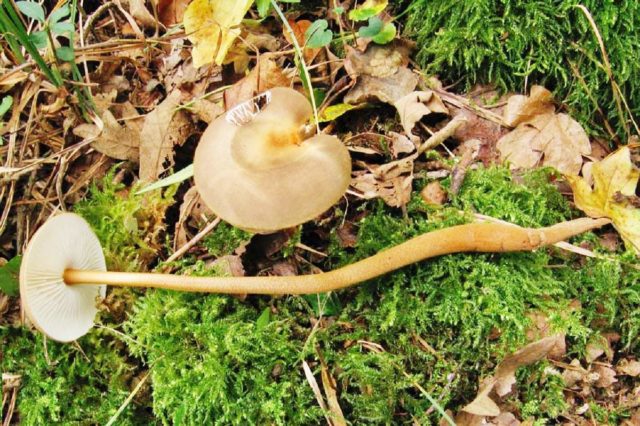
Description of the hat
This species is distinguished by a small cap, up to 80 mm in diameter. At a young age, it is convex, straightens with age, and the edges are bent upward. The central tubercle remains, then depressions and wrinkles appear. Dry, velvety, dense skin is colored lemon brown or dark gray. On the lower part there are rare snow-white plates, partially connected to the leg.
Xerula reproduces by colorless elliptical spores in a spore powder.
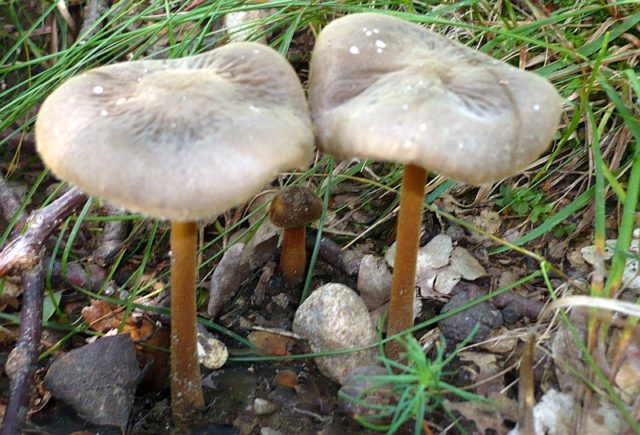
Leg description
The species got its name because of the thin, very long legs. Its thickness is about 30 mm, and its length is up to 15 cm. The leg is buried in the ground, which makes the mushroom more resistant. The shape can be round-cylindrical or flat. Thin velvety scales are colored to match the color of the cap.
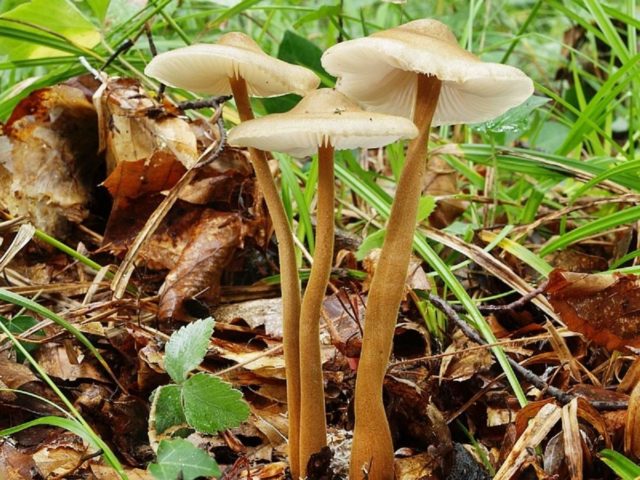
Is the mushroom edible or not
A rare specimen is edible. It has snow-white tasty pulp, with a light pleasant aroma. Therefore, delicious stewed, salted, pickled and fried dishes are obtained from it.
Where and how it grows
The long-legged hymnopus is a rare specimen. It prefers to grow on stumps, in the dust, on the roots of deciduous trees. The fungal representative grows in small groups. The fruiting period is July-October.
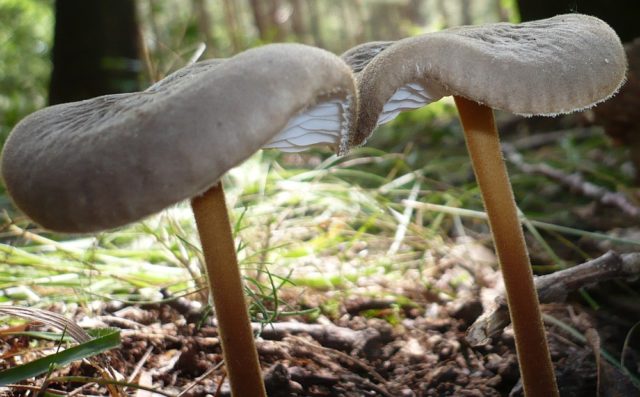
Doubles and their differences
In order not to be mistaken during mushroom hunting, you need to know that Gymnopus has doubles. These include:
Collibia root is an edible species, very similar to a long nail with a small slimy cap, colored brown. When squeezed, the root part does not change shape and remains rounded.
Scaly plyute is an inedible specimen, which is distinguished by a gray cap with not adherent plates. Fruiting occurs from late spring to early July
Important! Scaly barnacles can cause food poisoning. Collibia spindle-footed - a poisonous variety
It has a tough flesh and a reddish-brown cap that discolors with age. Fruiting occurs from late spring to mid-summer.
Xerula hairy - refers to the conditionally edible representatives of the mushroom kingdom. You can recognize it by a long leg and a large hat with a fleecy bottom. In adult specimens, the edges are strongly curved upward, which makes it easy to see thin plates. Prefers to grow in groups in mixed forests. Fruiting occurs from mid-summer to late September.
Conclusion
Long-legged Xerula is a rare species that prefers to grow in deciduous forests. The edible mushroom, thanks to its delicious pulp and delicate aroma, is used to prepare a variety of dishes.
Udemansiella root (Xerula radicata)
- Other names for the mushroom:
- Xerula root
- Root money
- Collibia tailed
Synonyms:

The current name is Hymenopellis radicata (according to Species Fungorum).
Udemansiella root attracts attention immediately, it is able to surprise with its appearance and is a very special species. Hat: 2-8 cm in diameter
But, due to the very high leg, it seems that the cap is much smaller. At a young age, it has the shape of a hemisphere, in the process of maturation it gradually opens up and becomes practically prostrate, while maintaining a noticeable tubercle in the center. The surface of the cap is moderately mucous with pronounced radial wrinkles. Changeable color, from olive, greyish brown to dirty yellow
Hat: 2-8 cm in diameter. But, due to the very high leg, it seems that the hat is much smaller. At a young age, it has the shape of a hemisphere, in the process of maturation it gradually opens up and becomes practically prostrate, while maintaining a noticeable tubercle in the center. The surface of the cap is moderately mucous with pronounced radial wrinkles. The color is changeable, from olive, greyish-brown to dirty yellow.
Pulp: light, thin, watery, without any special taste or smell.
Plates: moderately sparse, adhered in places in youth, then become free. The color of the plates as the mushroom matures ranges from white to grayish-cream.
Spore powder: white
Leg: up to 20 cm in length, 0.5-1 cm thick. The leg is deep, almost 15 cm immersed in the soil, often twisted, has a specific rhizome. The color of the stem ranges from brown at the bottom to almost white at the base. The pulp of the leg is fibrous.
Distribution: Udemanciella root is found from mid to late July. Sometimes it comes across until the end of September in various forests. Prefers tree roots and heavily decayed wood remains. Due to the long stem, the mushroom forms deep underground and only partially crawls out to the surface.
Similarity: The appearance of the fungus is rather unusual, and the characteristic rhizome process does not allow Oudemansiella radicata to be mistaken for any other species. Udemansiella root is easy to identify due to its lean structure, tall growth and powerful root system. It looks like a long-legged Xerula, but the latter has a velvety hat, has pubescence.
Edible: In principle, the Udemanciella root mushroom is considered edible. Some sources claim that the mushroom contains some medicinal substances. This mushroom can be safely eaten.
Notes: Udemanciella root is located at some distance from other types of mushrooms. It is easy to recognize at first glance: a very long leg and a short hat give the impression that nails are coming out of the ground, hammered by someone unknown, it is difficult to call it even a mushroom.
Xerula long-legged
Xerula long-legged - Latin Xerula longipes
In another way, this species is called the Long-legged Gymnopus, the Long-legged Colibia or the Long-legged Udimanciella.
Description
Mushroom cap
The long-legged hymnopus has a small cap, the diameter of which reaches 30-80 mm.At a young age, it has a conical shape with wide bent edges and a pronounced tubercle in the middle.
As the mushroom matures, the hat opens up so much that it often becomes completely flat, with even, semi-lowered or curved edges. The tubercle is often preserved, but notches appear on the caps - round and vertically - wrinkled. Slightly pubescent edges remain straight.
"Hats" are covered with a dry velvety skin, reminiscent of suede or velvet cardboard. It is yellowish - brown or brownish - gray, the middle may be darker or to match the cap.
Inside the caps there is a whitish thin flesh.
The bottoms of the hats are filled with sparse white plates growing or weakly attached to the stem.
Xerula long-legged reproduces by smooth, elliptical, unpainted spores contained in a white powder.
Stipe
The long-legged Collibia got its name for a reason: its leg is really extremely long. The thickness of the legs is about 30 mm, the height is from 70 to 150 mm, and they go deep into the environment in which they grow, thickening downward. The shape of the leg in most cases is round - cylindrical, but sometimes it looks like it got under the press, it can be so flat.
The leg is painted in the same colors as the cap and is covered with dry velvet skin.
Xerula long-legged - Latin Xerula longipes
Growing places
Udimansiella long-legged is a rare mushroom that prefers stumps and roots of deciduous trees: beech, hornbeam, oak and others. It is rarely found on larch stumps and roots. Fruiting usually occurs in few groups - 2-3 mushrooms each, and falls in July - early October.
The pulp of such a rare fungus exudes a pleasant smell and has a good taste, and therefore is considered suitable for eating in any form - stewed, fried, dried, salted or pickled.
Edible mushrooms, berries, herbs
Collybia fusipes
Spindle-footed collibia can be found from the second decade of July to the third decade of September in deciduous forests (most often, where there is an oak or a beech). It prefers to grow near oak (beech) stumps, tree roots, along fallen trunks, around stumps. It grows in rather large groups, united in bundles-aggregates. It is most widespread in the southern regions of our country.
The cap is 3-8 cm in diameter. At first, it is bell-shaped, later it is convex-tuberous with a smooth surface. The color is brownish-brownish or reddish-reddish-brownish with a darker center. In adults, the surface of the cap is most often uneven with cracked edges, while the color becomes lighter. Also, specks of red-brown color may appear on the surface.
The plates are sparse, medium-frequency, weakly accrete, grayish-white with reddish-brown spots.
The leg has a fusiform shape, swollen just below the middle. 6-9 cm long, 0.5-1.8 cm in diameter. The structure is longitudinally fibrous, wrinkled-furrowed. In the swollen part it is almost hollow, light at the top, red-brown at the bottom, brown at the very base. Very often, the leg is twisted or twisted longitudinally.
The pulp is white, thin-fleshy, elastic, harsh in the leg, with a subtle smell.
It is considered a weakly poisonous mushroom. However, in some reference books it is equated to edible or conditionally edible. For example, the French mycologist-writer Gerard Oudou in his encyclopedia "Mushrooms" advises to collect the caps of young spindle-footed colibia and use them fresh or pickled.
Photos of Collybia fusipes



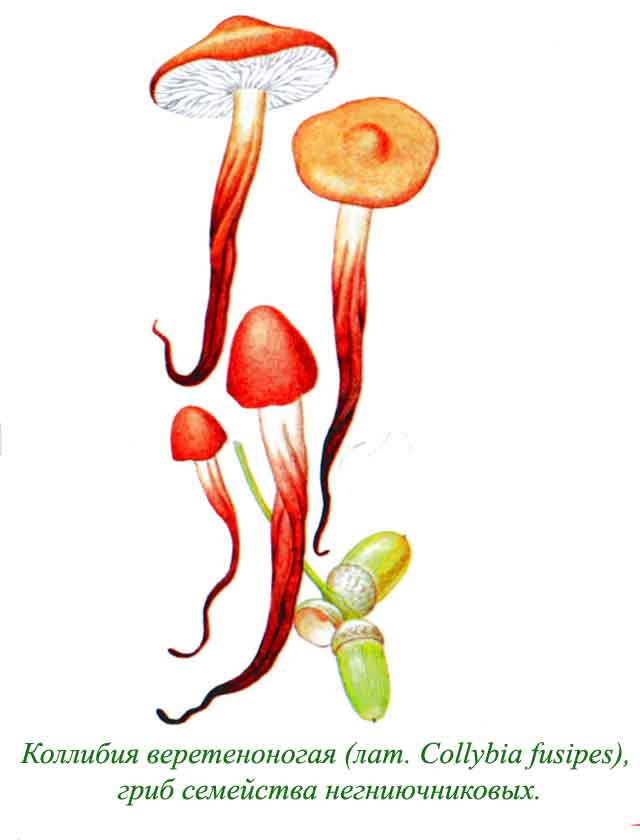
A video about spindle-footed collibia, which allows you to better understand the structure of the fruiting body and imagine how a mushroom grows in the forest.
Xerula root
Xerula root - Latin Xerula radicata
In another way, this delicate fungus is called Udemansiella root, Xerula rooting, Colibia tailed, Udemansiella root, Odimansiella radiant, Money root or Odimancela root.
Description
Mushroom cap
Outwardly, Kolibia's tailed hat looks tiny, although in reality its diameter is 20-80 mm. It is visually diminished by a thin leg, more reminiscent of a nail shaft.
Young mushrooms have hemispherical rounded caps; in adult specimens, they open almost to an absolute plane and look like coins with a slight elevation in the middle.
The hat surface is damp and covered with clearly visible wrinkles. It is colored in any of the following shades: grayish brown, olive, dirty yellow. In this case, the colors may vary.
Xerula's rooting hat fills with a delicate, watery, pale flesh.
The hat bottom is formed by sparse plates that grow at a young age and are free at a mature age. The plates are light in color from white to creamy gray.
The fungus is propagated by spores contained in white spore powder.
Stipe
Xerula root has a very long stem, reaching 20 cm in height and 10 mm in thickness, with another 13-15 cm immersed in the ground. The stems often grow twisted and turn brown, turning into almost white from top to bottom. The legs are filled with fibrous pulp.
Xerula root - Latin Xerula radicata
Growing places
Odimansiella radiant grows in mixed and deciduous forests, growing in flat and hilly areas. The ideal medium for the fruiting of this mushroom is rotten wood in the form of stumps and dead wood. Remaining half in the ground, the mushroom grows through the rotten dust and is shown to the light.
The fungus bears fruit singly or in a group of three or more specimens. Fruiting occurs in mid-July - early October.
Edibility
Although the pulp of xerula does not exude a special aroma and does not have a pronounced taste, it is classified as an edible mushroom. Only caps are eaten, since the fibrous flesh after cooking becomes too coarse.
Similar types and differences from them
Edible
Xerula is long-legged. It has the same refined stem and general structure, but differs from Xerula root in a velvety grayish cap.
Inedible
Scaly rods. It looks like a collision with a thin leg and a hat shape, but differs in that its plates do not reach the legs.






